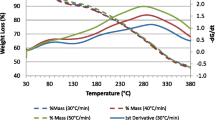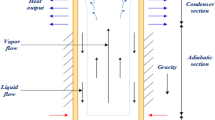Abstract
This work developed a computational fluid dynamics (CFD) model to analyze and optimize the design of a heat-not-burn tobacco (HnB) device, which is an electrically heated tobacco product. The associated mathematical models were derived to express the fluid flow and pyrolysis of tobacco porous media, which is assumed to follow Darcy’ law. In addition, an apparent kinetic model was implemented as a submodel to represent tobacco pyrolysis reactions. Simulation results of the CFD model were compared with experimental data for validation. The results elucidate the interplay between the heat transfer inside the tobacco substrate and the pyrolysis reactions. Case studies were conducted to reveal that the chemical components generated in the HnB are strongly affected by the temperature distribution inside, which can be controlled by the heater design and operation. This leads us to suggest a new design which has dual heat sources of a needle heater and a wall heater controlled at 468 K. The proposed design is shown to increase the nicotine generation rate by 4.6 times while generating less amounts of harmful and potentially harmful constituents (HPHCs).
Similar content being viewed by others
References
E. Simonavicius, A. McNeill, L. Shahab and L. S. Brose, Tobacco Control, 28, 582 (2018).
M. Forster, C. Liu, M. G. Duke, K. G. McAdam and C. J. Proctor, C. J., Chem. Cent. J., 9, 1 (2015).
R. R. Baker, Thermochim. Acta, 28, 45 (1979).
R. R. Baker and L. J. Bishop, J. Anal. Appl. Pyrol., 71, 223 (2004).
M. A. Wojtowicz, R. Bassilakis, W. W. Smith, Y. G. Chen and R. M. Carangelo, J. Anal. Appl. Pyrol., 66, 235 (2003).
M. K. Akalin and S. Karagöz, BioRes., 6, 1520 (2011).
A. Gómez-Siurana, A. Marcilla, M. Beltrán, D. Berenguer, I. Martínez-Castellanos, L. Catalá and S. Menargues, Thermochim. Acta, 587, 24 (2014).
F. Barontini, A. Tugnoli, V. Cozzani, J. Tetteh, M. Jarriault and I. Zinovik, Ind. Eng. Chem. Res., 52, 14984 (2013).
M. Muramatsu, Beiträge zur Tabakforschung International/Contributions to Tobacco Research, 21, 286 (2005).
S. Talih, Z. Balhas, R. Salman, R. El-Hage, N. Karaoghlanian, A. El-Hellani, M. Baassiri, E. Jaroudi, T. Eissenberg, N. Saliba and A. Shihadeh, Aerosol. Sci. Technol., 51, 1 (2017).
S.-C. Yi, E.-S. Song and M. R. Hajaligol, J. Fire Sci., 19, 429 (2016).
B. Eitzinger and S. Pirker, Beiträge zur Tabakforschung International/Contributions to Tobacco Research, 21, 403 (2005).
M. S. Saidi, M. R. Hajaligol and F. Rasouli, Beiträge zur Tabakforschung International/Contributions to Tobacco Research, 21, 157 (2004).
M. S. Saidi, M. R. Hajaligol and F. Rasouli, J. Anal. Appl. Pyrol., 72, 141 (2004).
W. Jianhui, D. Wen, Z. Kejun, Z. Xiaobing, P. Bin and L. Huimin, Tobacco Sci. Technol., 48, 39 (2015).
Z. Jiang, X. Ding, T. Fang, H. Huang, W. Zhou and Q. Sun, J. Phys.: Conference Series, 1064, 012011 (2018).
M. Nordlund and A. K. Kuczaj, ECI Symposium Series (2016).
W. M. Deen, Introduction to chemical engineering fluid mechanics, Cambridge University Press, Cambridge (2016).
ANSYS, Fluent udf manual 18.0, ANSYS, Inc. (2017).
ANSYS, Fluent users guide 18.0, ANSYS, Inc. (2017).
R. Goel, Z. T. Bitzer, S. M. Reilly, J. Foulds, J. Muscat, R. J. Elias and J. P. Richie, Chem. Res. Toxicol., 31, 325 (2018).
B. G. Im, S. W. Kim, J. H. Kang and Y. J. Yang, J. Korean Acad Fam. Med., 22, 674 (2001).
Acknowledgement
This research was supported by Korea Tomorrow & Global (KT&G) Corporation and Korea Institute for Advancement of Technology (KIAT) grant funded by the Korea Government (MOTIE) (P0008475, The Competency Development Program for Industry Specialist).
Author information
Authors and Affiliations
Corresponding author
Rights and permissions
About this article
Cite this article
Kim, S.H., Choi, H., Jung, Y. et al. Numerical analysis of the coupling between heat transfer and pyrolysis in heat-not-burn tobacco using computational fluid dynamics. Korean J. Chem. Eng. 39, 2907–2915 (2022). https://doi.org/10.1007/s11814-022-1272-3
Received:
Revised:
Accepted:
Published:
Issue Date:
DOI: https://doi.org/10.1007/s11814-022-1272-3




